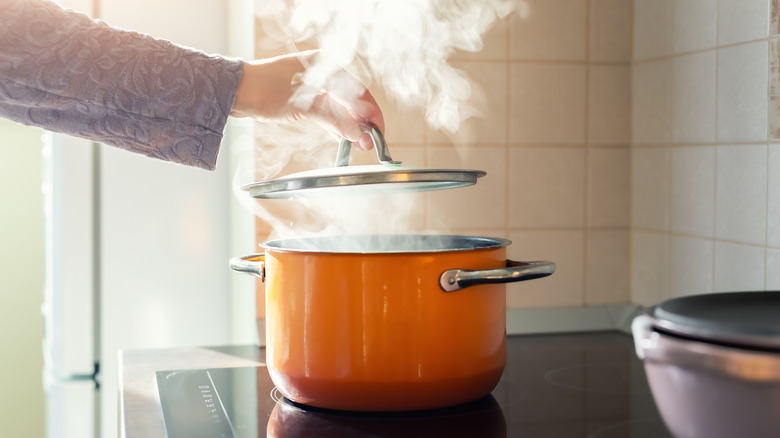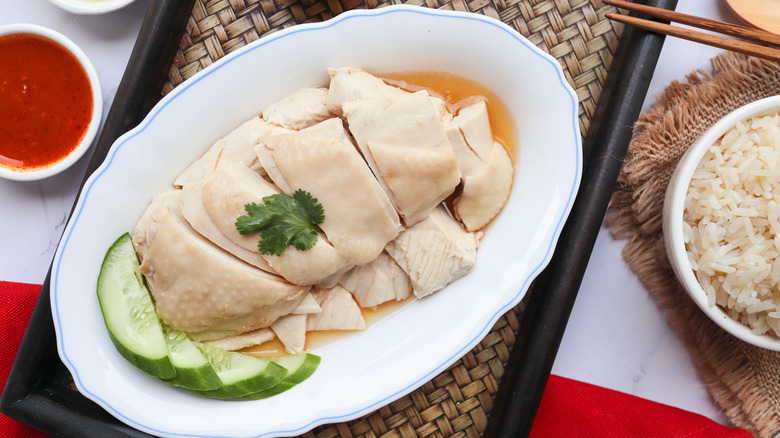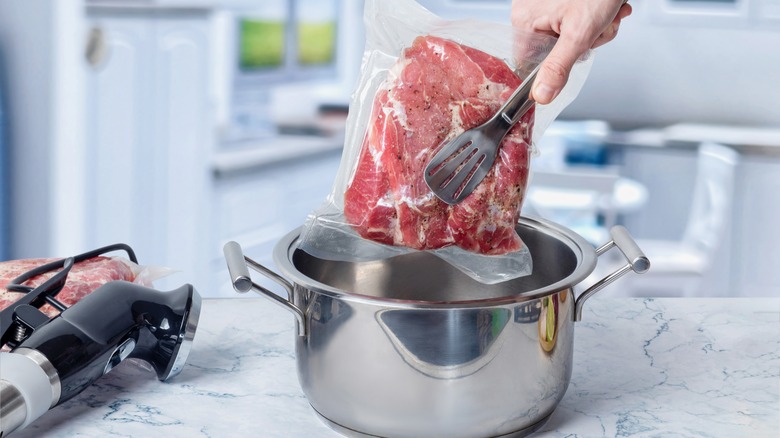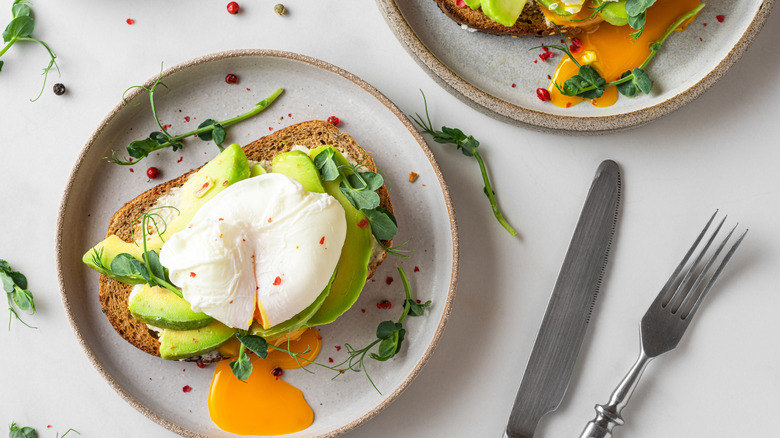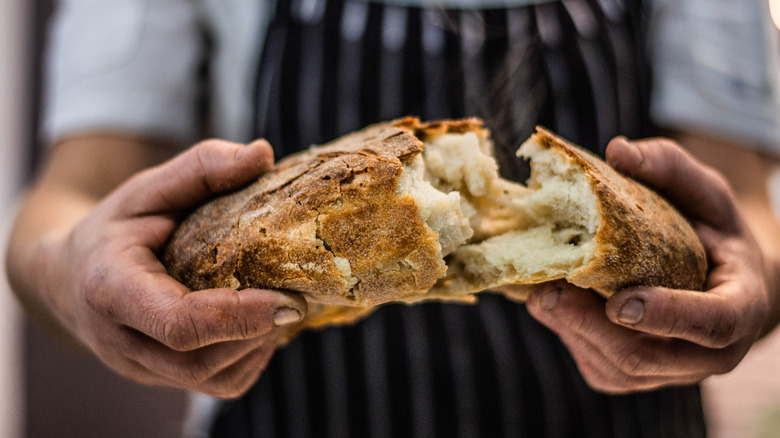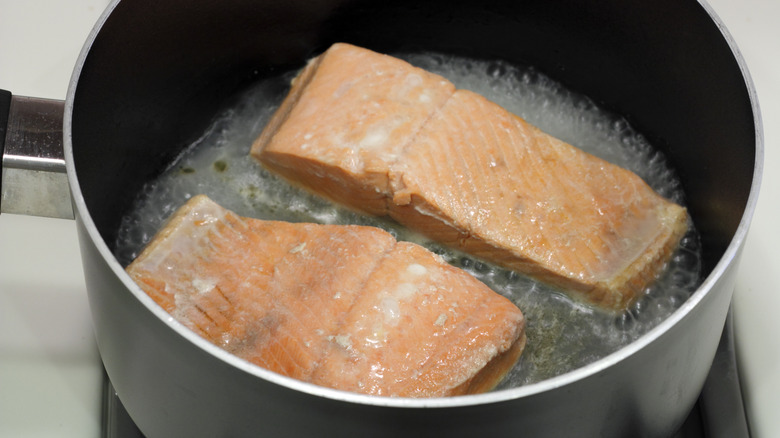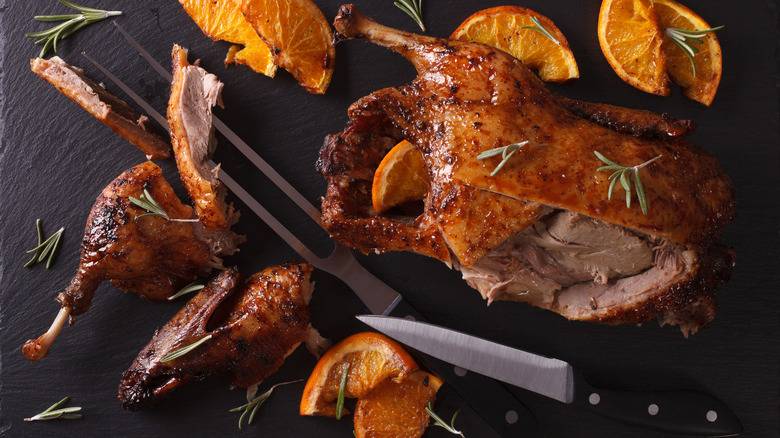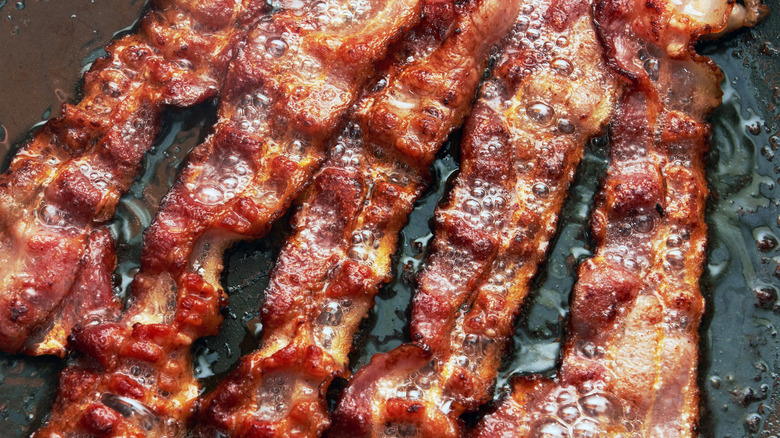7 Foods You're Not Cooking In Water But Should Be
Water is as fundamental to cooking as it is to anything else in the world. Although food can be cooked in many ways, some of the most basic cooking methods use water as their primary source of heat. Boiling, steaming, and blanching are just some cooking methods involving water that occur daily in kitchens worldwide. And these techniques produce incredible results time and time again, for a wide variety of food.
But here's the kicker, folks: Once people learn a cooking method for a certain food, they tend to stick to it. You've always grilled hot dogs or fried your steak, so why would you do it any other way? Well, because mixing up your techniques can produce incredible results, that's why. Water can be used to cook a huge range of foods in delicious ways. And it's not just your vegetables or carbs that are improved by a bit of H2O. Proteins, baked goods, and even breakfast favorites can be made even better if you're cooking them in water. So fill up your kettle, and let's take a look at some foods that are made even more wondrous by water.
1. Chicken
As one of the world's core meat staples, chicken can be cooked in pretty much any way you care to name. But frequently, these methods tend to involve drier sources of heat, like roasting, grilling, and frying. Cooking chicken in water, however, is a fantastic way to produce a tender, succulent piece of meat. When done correctly, poaching chicken provides a juicy result, using a cooking method that relies on no fat whatsoever.
This method isn't as simple as throwing a chicken breast into boiling water, however, so make sure you're not poaching chicken wrong with some simple rules. The first is to ensure that you're not cranking the heat up too high. Rapidly boiling water will cause the protein to become tough and dry, which is the last thing you want. Instead, you'll want to poach your meat on as low a simmer as possible. This will allow the meat to cook gently, keeping its juices in and maintaining its internal moisture.
Importantly, while chicken poached solely in water can produce a great neutral-tasting result, adding aromatics can amp up its flavor. Using root vegetables and herbs, as this simple poached chicken recipe does, can imbue the meat with flavors that work in a range of dishes. Adding some salt to your pot of water can also help to augment the chicken's tastiness.
2. Steak
Cooking steak in water? Surely not. But, although it may sound like a bizarre way to get a steak to the table, it actually does work — using one specific method. Water is an integral part of the sous vide method, a cooking technique that uses gentle heat to create incredible results.
Sous vide (which translates to "under vacuum") involves placing sealed bags of food in a bath of water at a set temperature. The food then cooks gently and slowly, much as it would in a low-temperature oven or slow cooker. This low, consistent temperature produces a tender, mouthwatering result, particularly with proteins like steak, as the meat doesn't dry out or become tough. Once cooked, all you need to do is remove it from the bag, serve it up, and enjoy.
Sounds pretty simple, right? Additionally, with sous vide steak, you can place seasonings right in the bag so that they can flavor the meat gently as it cooks. As you might expect, though, to sous vide food, you'll need to acquire some equipment. Luckily, at-home sous vide machines are more widely available than ever before, or you can grab an immersion circulator and make your own. But when the results are this good, it's an investment that'll likely pay off.
3. Eggs
Few foods have as many cooking methods as eggs do. From fried to scrambled, baked to boiled, no matter how these little bombs of protein and taste get to the table, they're usually delicious. And poaching eggs is one cooking technique that we think needs a little more love. Poaching eggs correctly produces a perfectly tender result, with a pillowy egg white that surrounds an oozing yolk.
Although poached eggs aren't exactly uncommon, they're often avoided thanks to how tricky they're thought to be. In truth, though, all it takes to master them is a little bit of technique. To poach an egg perfectly every time, start with a deep pot of water. Add a few tablespoons of white vinegar, which helps the egg cohere together and firm up in the water.
Then, bring the water to slightly under boiling temperature, and while it's heating up, grab a small container and crack your egg in. Pouring the egg from a container helps you to control its insertion into the water. Once the water reaches temperature, swirl it and slowly pour the egg in. The swirling motion stops the egg from spreading out under the water and creating a stringy mess. Cook the egg at this gentle heat for a few minutes and then remove it carefully from the water. Let the moisture steam off, pop it onto a slice of toast, and you're good to go.
4. Bread
Few things are better in life than a perfectly cooked loaf of bread. The crispy, browned crust with a cloud-like interior crumb lurking underneath ... it's heaven, y'all. But when we think of making bread, we generally think of using the dry heat of an oven to bake it, right? While ovens and bread are a match made in heaven, utilizing water in the cooking process can produce incredible results. The secret to a good bagel, for example, is the boil each one undergoes before it's placed into the oven to bake. The boiling water helps to keep the inside dense and chewy while permitting the surface to brown up.
You don't have to have a ready-to-go bagel factory at home to harness the power of water for your bread, though. All you need is a large pot and a tap for an incredible hack for baking bread. Instead of putting your loaf tin full of dough in the oven, place a rack in a crockpot and place the tin on top. Then, pour in water, until it comes to about halfway up the loaf tin. Turn on the heat and allow the water to simmer gently for two to three hours. The heat from the water and the steam released from it will cook the bread, producing a moist, succulent loaf.
5. Fish
Given that fish originate from the water, it only makes sense that they should return from whence they came. And that's why we think it's high time to start cooking fish more often using the liquid that they call home. Poaching fish is an excellent alternative to dry heat methods of cooking it and produces delectable results. The gentle cooking action of water is perfect for fish's delicate flesh, which can quickly dry out when cooked at high, dry temperatures.
Remember, though, that fish can become dry and rubbery even when you're poaching it. So, for moist poached fish every time, make sure you're using one important trick: Bring your pot of water to just boiling and then remove it from the heat. Then, place your fish fillet in the water and add a small amount of cold water to bring the temperature down slightly. Put the lid on your pot and then leave the fish to cook through gently. Doing this will ensure that the fish flesh remains totally juicy and tender. It's worth remembering, however, that this method is best when you're not seeking to serve your fish hot. You may also want to season your cooking water with herbs, spices, vegetables, and salt to add further flavor.
8. Duck
Duck is one of life's true delicacies. But perhaps because it's slightly less common than other meats, it can be tricky to know how to cook. Learning how to use water in its cooking process, though, can have you producing amazing duck time and time again. As a slightly fattier meat with succulent skin, roasting duck is the perfect way to achieve a crispy exterior. Before you put it in the oven, though, spend a minute or two pinching the skin on the bird. This will create some space between the skin and the meat. Then, take a ladle or jug of boiling water and pour it over the bird, before letting it cool and refrigerating. This makes the duck skin tighter and dryer, meaning that it will roast and crisp wonderfully.
And, if you have any leftover pieces or cuts you're not using when cooking with duck, water is your best friend. Take the pieces that have the most fat on them and pop them in a water-filled pot. Then, boil them for a little while, until the fat from them rises to the top, and then take off the heat. As the fat cools, it'll solidify, and you can skim it off the top and put it in a jar. You can then use it for roasting potatoes, vegetables, or anything else that needs a touch of luxury.
11. Bacon
Okay, so cooking your bacon in water may not seem like the most appetizing idea in the world. But trust us on this one: Once you add H2O to your bacon, you'll never look back. Cooking bacon in water is a quick and easy way to, believe it or not, produce a super-crispy result. The addition of water prevents the fat from splattering all over your stovetop and kitchen surfaces as it cooks. Then, once it evaporates, the bacon crisps up beautifully, creating that inimitable crunchy texture, with an enviable chewiness to the meat.
The best part is that cooking bacon with water is very easy. Just grab your favorite skillet and place your bacon pieces in, as you would normally. Then, add a little bit of water, so that the bacon is just covered. Turn on the heat and bring the water to a boil, allowing it to steam away and cook the bacon. Once the water evaporates, allow the bacon to continue cooking and frying in its now-rendered fat. Do this for a few minutes, or until your bacon has achieved your desired done-ness. Remove it from the pan, place it on your plate, and devour it with joy and satisfaction in your heart.
